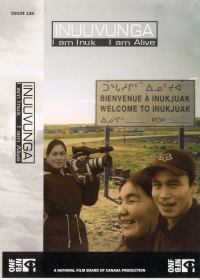| ________________
CM . . .
. Volume XI Number 17 . . . . April 29, 2005
Inuuvunga is the brainchild of the NFB who sent two filmmakers, Daniel Cross and Mila Aung-Thwin, to the Innu community of Inukjuak, in northern Quebec, where they collaborated with eight students in the high school graduating class to produce a video documenting what life is like for Innu teenagers in their town. The result is a haunting look into another culture that is so near and yet so far from Canadian urban culture. The film opens with the startling image of some of the students only feet away from thousands of caribou. To these students, a common image, to the viewer, a gasp creating shock that immediately sets the tone of the film: we live differently than you do; our life is wonderful. The video shows how the students learn to use the cameras and includes the taping of their interviews with parents and grandparents, the filming of their out of school activities, such as fox hunting, x-country skiing, snowmobiling, driving 4 wheel drive vehicles, the community's New Year's Eve party, talking with teachers, hunting geese, building igloos and their first trip to Montreal's urban, white culture. There are many fascinating typical family images that seem so casual but illustrate the culture divide so sharply. A family eats raw caribou from a piece of cardboard on the kitchen floor while Mother snaps her ulu (the woman's knife) back and forth to sharpen it. In a seal gutting in a classroom, spectators are asked if they want the liver or the eyeball to eat (delicacies). One of the teenagers' rooms is plastered with posters of modern rock groups. A women's sewing group sits together with some women biting leather, others telling myths and the teenagers listening carefully. One of the mothers skates with her children and does homework with them. Her husband is almost mute, very uncomfortable with the camera/interview situation while his wife chatters and laughs. Two young women hold each other's forearms and compete with each other by throat singing. Although it is clear that the strongest, healthiest, most outgoing people in this community are women, it is the interviews with the grandparents that are the most amusing and shocking. Asked what he remembers most about his childhood, an elderly man immediately says that they were usually hungry and they lived in tents. A grandmother laments that teenagers are sooooo tired and manage to do only half the amount of work she could do at their age. Grandfather Lucassie demonstrates some traditional skills such as igloo building and fox hunting. Another older man refuses to answer questions put to him by the teens, saying that an adult has to ask the questions. Teenagers are only supposed to observe, not ask questions. The teens also film each other in short bursts of energy, playing in the snow, talking with the RCMP, at a house party and just goofing around. The charming images of young children and babies show that the filmmakers adore them and are determined to do a good job of looking after their own children. Two of the grade 12 girls who have children comment that they have kept going because of their children. The filming done by the students sometimes reflects the level of ability that you might expect from beginning teen camera people. Their subjects make faces, shout and display other silly antics that don't do much to advance the theme. This results in a video that is too long, an awkward length to show in a classroom setting and in need of some editing to illuminate the theme more clearly. However, there are some stunning shots that indicate that some of these students not only understand the theme but can convey it through images that evoke pure emotion: Dora, skating circles on the hockey rink; the vast Arctic landscape extending as far as the eye can see; teens tumbling in the snow and the annual skidoo ride. This video is in Inuktituk, subtitled in English, which demonstrates that the Inuit are a separate culture, and does not detract from the viewing pleasure. In the classroom, these teens are taught in French so they are all tri-lingual. One of the themes the students are interested in is suicide. Why, they ask everyone, do they think young teens commit suicide? The older people interviewed attribute suicide to drugs and alcohol. No one talks about loss of culture, or the coming of new technologies that have changed the Inuit way of life. Dora, one of the grade 12 students, commits suicide, and the other students' bewilderment and mourning is clear. There is only one image of a wild party at which the viewer might think the partygoers are drunk or high. Otherwise alcohol and drugs are not filmed by the students. One wonders if this was a view of their community that they didn't want to expose, or if indeed it is not a problem. The older people are clear in their condemnation of addictions and bingeing. The video is dedicated to Dora. Inuuvunga would be useful for high school students studying the way of life of first nation people in Canada both in the present and the past. Recommended. Joan Marshall is the teacher-librarian at Fort Richmond Collegiate in Winnipeg, MB.
To comment
on this title or this review, send mail to cm@umanitoba.ca.
Copyright © the Manitoba Library Association. Reproduction for personal
use is permitted only if this copyright notice is maintained. Any
other reproduction is prohibited without permission.
NEXT REVIEW |TABLE OF CONTENTS FOR THIS ISSUE - April 29, 2005. AUTHORS | TITLES | MEDIA REVIEWS | PROFILES | BACK ISSUES | SEARCH | CMARCHIVE | HOME |
